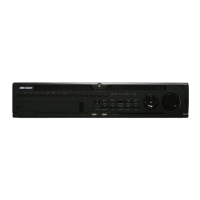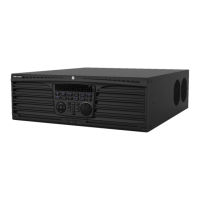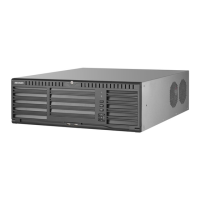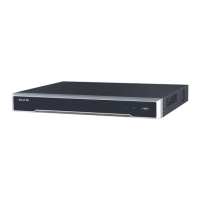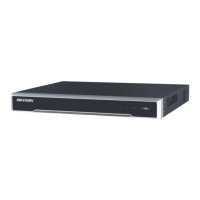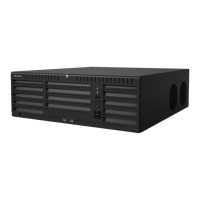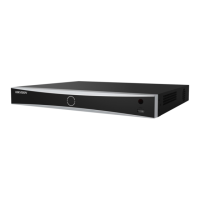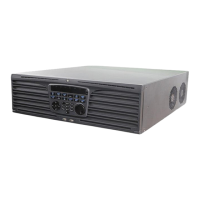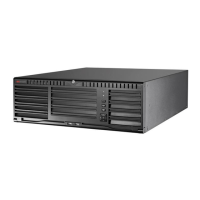Do you have a question about the HIKVISION DS-9600 Series and is the answer not in the manual?
Procedures for properly starting up and shutting down the NVR to extend its lifespan.
Step-by-step guide to configuring the NVR using the initial setup wizard.
Instructions for adding and connecting IP cameras to the NVR, including online and customized protocols.
Details on operating the live view mode, including single/multi-screen, auto-switch, and output modes.
Setting up PTZ parameters, including camera selection and protocol configuration.
Steps to set and call PTZ presets, customize and call patrols, and customize/call patterns.
Defining image quality, stream type, resolution, and other parameters for recording.
Setting schedules for automatic recording or capture for cameras.
Setting up motion detection parameters, areas, sensitivity, and trigger actions.
Configuring recording or capture triggered by alarm inputs.
Locking recorded files or setting HDD property to Read-only to prevent overwriting.
Methods for playing back recorded video files by channel, time, search, event, tag, or logs.
Features like frame-by-frame playback, digital zoom, and multi-channel adverse playback.
Exporting record files via quick export, normal search, event search, or video clips.
Configuring motion detection areas, sensitivity, and alarm response actions.
Defining actions like full screen monitoring, audible warning, and email notifications for alarms.
Basic network configuration including working mode, IP address, and DNS settings.
Creating disk arrays and virtual disks using one-touch or manual configuration.
Automatic and manual procedures for rebuilding arrays when disks fail or degrade.
Steps to initialize a newly installed hard disk drive before use.
Procedures for properly starting up and shutting down the NVR to extend its lifespan.
Step-by-step guide to configuring the NVR using the initial setup wizard.
Instructions for adding and connecting IP cameras to the NVR, including online and customized protocols.
Details on operating the live view mode, including single/multi-screen, auto-switch, and output modes.
Setting up PTZ parameters, including camera selection and protocol configuration.
Steps to set and call PTZ presets, customize and call patrols, and customize/call patterns.
Defining image quality, stream type, resolution, and other parameters for recording.
Setting schedules for automatic recording or capture for cameras.
Setting up motion detection parameters, areas, sensitivity, and trigger actions.
Configuring recording or capture triggered by alarm inputs.
Locking recorded files or setting HDD property to Read-only to prevent overwriting.
Methods for playing back recorded video files by channel, time, search, event, tag, or logs.
Features like frame-by-frame playback, digital zoom, and multi-channel adverse playback.
Exporting record files via quick export, normal search, event search, or video clips.
Configuring motion detection areas, sensitivity, and alarm response actions.
Defining actions like full screen monitoring, audible warning, and email notifications for alarms.
Basic network configuration including working mode, IP address, and DNS settings.
Creating disk arrays and virtual disks using one-touch or manual configuration.
Automatic and manual procedures for rebuilding arrays when disks fail or degrade.
Steps to initialize a newly installed hard disk drive before use.
| Model | DS-9600 Series |
|---|---|
| Type | NVR (Network Video Recorder) |
| Operating Temperature | -10 °C to +55 °C (14 °F to 131 °F) |
| Video Compression | H.265+/H.265/H.264+/H.264 |
| Video Output | HDMI, VGA |
| Recording Resolution | Up to 12MP |
| Hard Disk | SATA |
| HDD Capacity | Up to 10TB capacity for each HDD |
| RAID Type | RAID 0, 1, 5, 10 |
| Audio Output | RCA |
| Network Interface | 10/100/1000Mbps Ethernet |
| USB Interface | 2 x USB 2.0, 1 x USB 3.0 |
| Alarm In | 16 channels |
| Power Supply | 100 to 240 VAC, 50 to 60 Hz |
| Operating Humidity | 10% to 90% |
